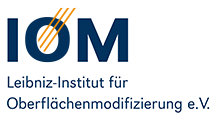To ensure that laser fusion power plants operate efficiently and reliably, the laser technology must be adapted to high power levels and continuous operation. In the “nanoAR” research project, nine partners from industry and research are developing methods to improve optical components. The collaborative project, which is scheduled to run until 2027, also involves researchers from the IOM research field “Ultra-precision Surfaces/ Ion beam assisted patterning and smoothing” and is funded by the Federal Ministry of Education and Research (BMBF) with six million euros as part of the funding program “Enabling Technologies for Fusion – Towards a Fusion Power Plant”.
In order to pave the way for viable solutions, the project partners are relying on nanostructured or nanoporous antireflective coatings based on materials with a high band gap, which should ensure the necessary resistance to laser radiation. On the other hand, they are testing a subtractive approach: Instead of a combination of a substrate material and several layers of material applied to it for anti-reflection, they are relying on lenses made of a single material that is to obtain the desired anti-reflective properties through a suitable nanostructuring of its surface. Using the example of two materials with a large band gap (quartz glass and calcium fluoride), corresponding large-scale demonstrators are to be developed for different wavelengths and pulse lengths. Their approaches could also be transferred to other areas of application for high-performance optics.
In the “nanoAR” project, the project partners are combining their expertise in manufacturing and processing methods to effectively reduce SSD (subsurface damage) by means of technology-open process development for nanostructure generation, including the use of simulation and modeling, high-resolution material characterization and the development of new methods for quality assurance.
Further information here

